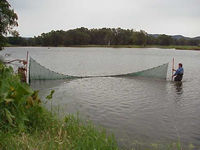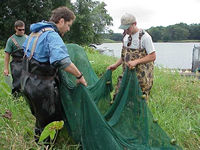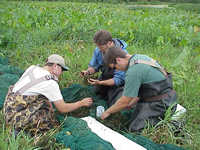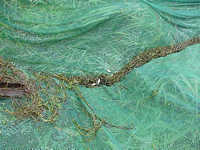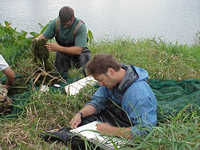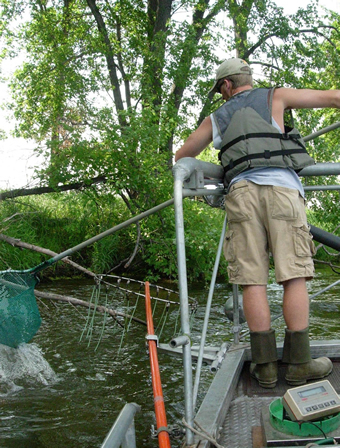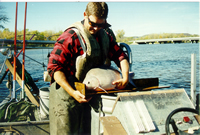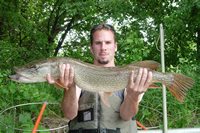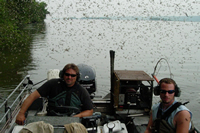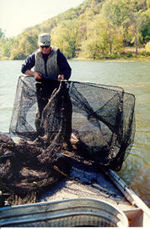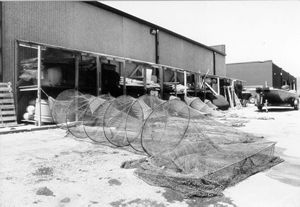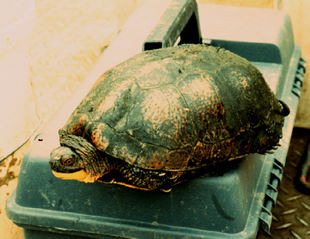|
Fish communities are monitored on Pool
8 through indices such as relative abundance and species richness,
along with the size structure of important species. The fisheries
component of the Wisconsin field station employs a standardized
array of active and passive gears (see photos) to monitor fish and
follows standard LTRM procedures (manual # 95-P002-1).
More specific information needed to interpret LTRM fisheries data
can be found at the following link: (fish
data format file.)
Fish data can downloaded in text format at this site as well (fish
data browser).
| 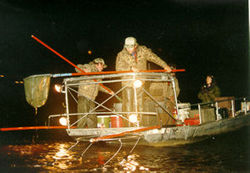
Night shocking was an optional gear used by the WDNR La Crosse
Field Station and some others. This method picked up some additional
fish species because fish move in and out of areas based on
the time of day or night.
(Photo by Terry Dukerschein) |
|
Like electroshocking, seining is an active
gear in that fish are pursued and caught within a brief period
of time. A net is swung in a 90-degree arc against a shoreline
to trap small fish. Seining is limited to side-channel and
channel-border areas relatively clear of structure and weeds
that would interfere with the action of the net. It takes
time to pick and sort through seined samples. Many of the fish caught in seines are preserved
for later laboratory identication because microscopes and
time are needed to examine structures critical for correct
identification of species.
Following program wide evaluation seining was discontinued in 2003.
(Photos by Terry Dukerschein) |
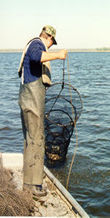 |
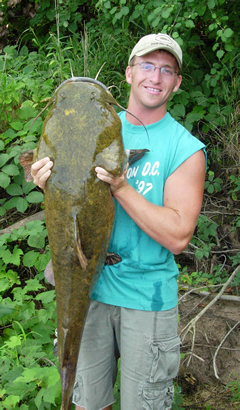 |
| Hoop nets are trap nets without leaders. A standard amount
of soybean cake bait attracts fish such as catfish, and hoop
nets can be set in deep water as well as shallow water. The standard LTRM set-time for hoop nets is approximately
48 hours (2 days). Like fyke nets, hoop nets are deployed
in two standard sizes, large for large fish and small for
small fish. |
La Crosse Field Station Team Leader
Telephone: (608) 781-6360
Fax: (608) 783-6066
|
|
|
|
Day electroshocking is the universal standard gear (fished
at all LTRM field stations in all types of aquatic areas).
A standardized electric current applied to the water by the
long booms that extend in front of the boat temporarily stuns
fish so that they are easy to see and capture with dip nets.
Fish recover almost immediately from the effect of the electricity
and are held in a live well until they can be identified,
measured, and released alive back into the river.
(Photos by Mi Ae Lipe-Butterbrodt) |
- Passive gears (the fish come into the gear on their own and
are trapped) deployed include hoop nets, fyke nets, mini fyke
nets, and tandem (immediately adjacent) sets of the various fyke
net and hoop net combinations.
- Active gears (the fish are actively pursued and captured) deployed
include seines, day and night electrofishing, and trawling. Fish
captured with either active or passive gears are identified, measured,
and released alive back into the river.
- Data on turtles incidentally trapped in passive gears are also
recorded. Turtles are identified, sexed, and measured before being
released back into the river.
- Gears are deployed at randomly assigned sites stratified by
five aquatic area (habitat) types (Main Channel [MC], Main Channel
Border [MCB—wingdam and unstructured], Side Channel [SC],
Contiguous Backwater [BWC], and Impounded [IMP—open water
and shoreline]).
- The LTRMP fisheries field-sampling season is divided into three
distinct time periods to allow for comparisons of seasonal differences
in fish distribution. The three periods are June 15 through July
31, August 1 through September 15, and September 16 through October
31.
- Each sampling period contains 150 stratified random sites throughout
Pool 8.
- Several fixed sites in the tailwaters of Dam 7, where fish
often congregate at certain times of the year and where certain
migratory species not captured elsewhere tend to congregate, are
also sampled.
- Occasionally, day electrofishing is done as funding permits in other areas.
|
|
Fyke nets are trap nets with leaders that
extend to a shoreline or weed bed to guide fish into the
net over approximately a 24-hour period. They fish well
in relatively shallow areas without little or no current
such as backwaters. No bait is used with fyke nets. LTRM
crews fish two standard-sized fyke nets--regular fyke nets
for larger fish and mini fyke nets scaled to catch young
fish and small forage fish in backwaters where weeds are
too thick to seine effectively. All nets must be regularly
maintained to be effective, including drying them after
each use, storing them in a well-ventilated, rodent-free
area, and vigilant mending.
|
|
Turtles occasionally find their way into fyke and hoop nets
because they are attracted by by the fish already caught in
the net. LTRM crews identify, measure, sex, and release all
turtles caught and record these data available in the fish
database. This Blandings Turtle is endangered because of loss of habitat.
It is the only one so far caught in Navigation Pool 8 LTRM
gears. After photographing it to document identification,
we notified appropriate museums and agencies of its occurrence
in our area and released it back into the river. |
|





